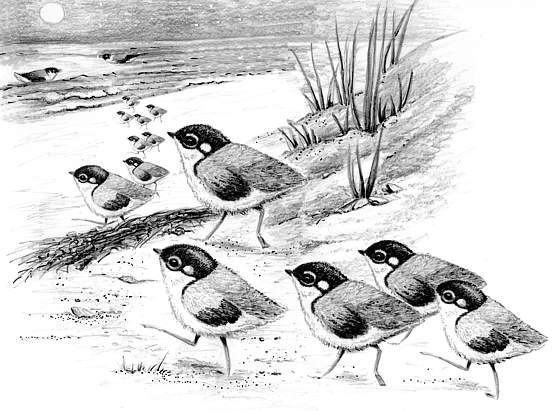
A Rare Event at West Dennis Beach
Dear Bird Folks,
I’m wondering if you can solve a mystery for me. I like to take my dog for late night walks along West Dennis Beach. The past few nights I have been hearing odd chirping sounds coming from the dunes just above the parking lot. I questioned some guy who happened to be there and he said that the sounds are coming from the “nesting bird colony.” I went back during the day and saw no signs of birds or a colony. However, the sounds were back that same night. Now it’s starting to bug me. Do you have any idea what these mystery sounds are?
-Stan, Dennisport, MA
Come on Stan,
Where’s your faith? If you can’t trust a stranger in a dark parking lot, who can you trust? Especially since that stranger may have been me. I was at the beach the other night and talked to some guy who was walking his dog. Is your dog kind of chubby, with jowls that look like Richard Nixon? I could tell the guy who I was talking to didn’t believe me. He wanted the mystery sound to be coming from insects. That was you Stan, wasn’t it?
No, it wasn’t insects. Yes, there is a bird colony. The sounds you heard are coming from a bird called an “Ancient Murrelet.” (Look it up, it’s a real bird.) Murrelets are members of the auk family. Most nest up north and only come to Cape Cod during the winter. However, the Ancient Murrelets are not your typical auks.
These murrelets used to be found exclusively in the Pacific Northwest, around Washington state and British Columbia. In recent years however, this little seabird has been setting up colonies along the east coast too. They are called “ancient” because they have faint white lines on the sides of their black heads. The white markings give them an “aging” look. (I certainly know that look.) Other than that, this bird is fairly dull. The only truly unique thing about these murrelets is their “invisible” nesting colonies.
The Ancient Murrelet is a stealth nester. You could have a colony in your own backyard and you would never know it, except for those weird calls. It happens like this. The female arrives, late at night, under the cover of darkness and flies directly into a tiny burrow that she digs into soft coastal sand. Once in the burrow, she lays her eggs and sits on them day and night, without food. She sits tight for three or four days, while her mate continues to feed well off shore. Then, just when she is about to call the Domestic Abuse Hotline, the male arrives, also under the cover of darkness. The male then has to sit on the eggs and starve for three or four days while the female feeds. The mystery chirps that you heard Stan were the hungry adults, way down in the borrows, calling for relief from their mates. This back and forth cycle continues for about thirty days, when finally, the young murrelets hatch out, the parents take off and the fun really begins.
Instead of bringing food to the newly hatched chicks, the adults swim just off shore and call. What happens next is truly one of the most amazing events in all of nature. Well after dark, on the first spring high tide, the entire colony of day old murrelet chicks, suddenly emerge from their borrows and race to the safety of the sea. The dunes come alive with scrambling black, fluffy, chicks, each trying desperately to reach their parents that are frantically calling from the dark, icy, cold water. (Have I painted this scene with enough dramatic adjectives?)
What’s doubly cool about this event is that West Dennis Beach is the only place in the east where we can witness this spectacle. You should check this out, it’s amazing, but don’t take the dog. Old Richard has to stay home this time.
It’s a one night event, on the evening of the first spring high tide. Arrive, dog-less, about 8:00 PM. Volunteers and natural resource people will instruct you where to go. You should have a flashlight; a headlamp works best. The light must have a red filter on it. Red Saran Wrap works fine.
Also, you should bring a fly swatter with colored ribbons tied to it. Even in the dark the baby birds will be attacked by hungry gulls. Waving the fly swatters helps to keep the gulls away long enough for the little chicks to escape to the water. Skunks and raccoons can also devastate the chicks, so everyone will be asked to clap their hands and sing “Rockin’ Robin” to keep the mammals away. For some reason, it works.
The important things to remember are to dress warm and that it happens at West Dennis Beach, on the evening of the first spring high tide, which is this Friday, April 1st.